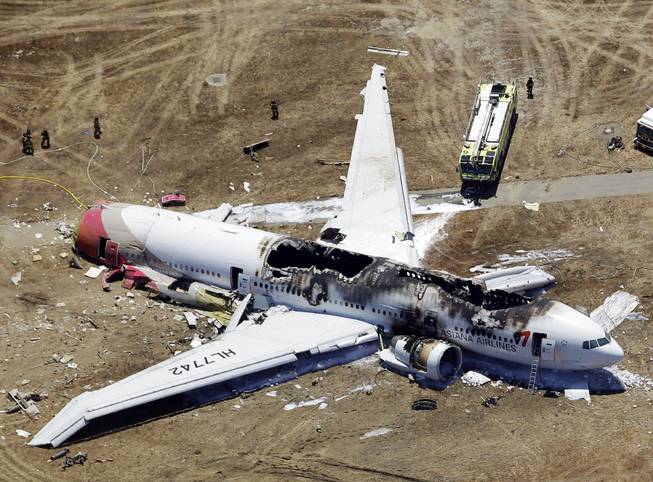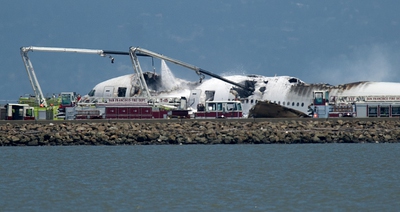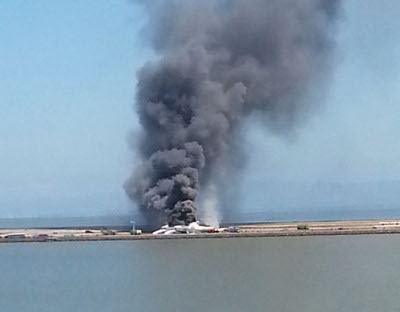
Associated Press
This aerial photo shows the wreckage of the Asiana Flight 214 airplane after it crashed at the San Francisco International Airport in San Francisco on Saturday, July 6, 2013.
Published Saturday, July 6, 2013 | 12:24 p.m.
Updated Sunday, July 7, 2013 | 10:24 a.m.
SAN FRANCISCO — An Asiana Airlines passenger jet traveling from Seoul, South Korea, crashed while landing Saturday at San Francisco International Airport, smashed into pieces and caught fire, killing at least two people and injuring more than 180 others.
Smoke billowed out of holes in the fuselage of the Boeing 777 on Saturday afternoon as firefighters rushed to douse the wreckage and passengers scrambled to safety down inflated escape chutes. The plane’s tail, landing gear and one of its engines were ripped off.
“It hit with its tail, spun down the runway, and bounced,” said one witness, Stefanie Turner, 32. Despite incredible damage to the plane, left dismembered and scarred, with large chunks of its body burned away, many of the 307 aboard were able to walk away on their own.
The flight originated in Shanghai, and the two people who were killed were Chinese women, the South Korean Ministry of Land, Infrastructure and Transport reported early Sunday. Joanne Hayes-White, the San Francisco fire chief, said 182 people were injured and 123 were unhurt.
“We observed multiple numbers of people coming down the chutes and walking to their safety,” Hayes-White said. At least five people were listed in critical condition at hospitals. The chief said the two bodies were discovered on the runway and that several passengers were found in San Francisco Bay, where, she said, they may have sought refuge from the fire.
One passenger, a South Korean teenager wearing a yellow T-shirt and plaid shorts, said the plane “went up and down, and then it hit the ground.”
“The top collapsed on people, so there were many injuries,” he said, referring to the overhead luggage compartments, before an airport official whisked him back into the Reflection Room, a quiet center in the airport for thought and meditation.
The crash comes after a remarkable period of safety for airlines in the United States. It has been four and a half years since the last airline crash — a safety record unmatched for half a century. The accident Colgan Air Flight 3407 (operating as Continental Connection Flight 3407), which crashed on approach to Buffalo (N.Y.) International Airport, killing 50 people, including one on the ground on Feb. 12, 2009. Globally, as well, last year was the safest since 1945, with 23 deadly accidents and 475 fatalities, according to the Aviation Safety Network, an accident researcher.
San Francisco General Hospital, the city’s trauma center, had received 52 patients as of 8:40 p.m. Eastern time Saturday, according to Rachael Kagan, a hospital spokeswoman.
Dr. Chris Barton, the chief of emergency services at the hospital, said, “We have seen a lot of patients with spinal injuries.” He said those injuries included spinal compression and burst vertebral bodies, the largest part of the vertebra.
Doctors also saw patients with fractures of their long bones and blunt-force injuries to the head and abdomen.
Some patients had been discharged, but the hospital provided no details.
It was not immediately clear what caused this plane to lose control on a clear summer day. The National Transportation Safety Board said it had dispatched a team from Washington to investigate, and declined to speculate. But witnesses said the plane approached the airport at an awkward angle, and it appeared that its tail hit before it bounced down the runway. When it stopped, they said, passengers had scant time to escape before a blaze burned through the fuselage.
“I looked up out the window and saw the plane coming in extremely fast and incredibly heavy,” said Isabella Lacaze, 18, from Texas, who saw the crash from the San Francisco Airport Marriott Waterfront.
“I remember watching the nose go to the ground and the tail way up in the air and then the tail back to ground hard,” Lacaze said. At that point, she said, the tail snapped off and the rest of the plane skidded down the runway.
“The smoke was not bad at all at first,” she said. “It was like one cloud. It took maybe a minute or two for the chutes to come out of the side,” she said, and people began to pour out almost immediately.
“The back got the worst of it,” a passenger on the plane, Elliot Stone, told CNN. He said the plane seemed to be coming in at a sharp angle and just as they reached the runway, it seemed to gain speed. It struck the tarmac with tremendous force, he said, and the people in the back of the plane “got hammered.” “Everybody’s head goes up to the ceiling,” he said.
Some passengers scrambled out of the plane even before the chutes deployed, he said. A number of people lay injured near the wreckage for 20 to 30 minutes before ambulances arrived, Stone said. Many people got off relatively unscathed, he said, but he saw at least five people with severe injuries.
David Eun, who said in a Twitter message that he had been a passenger on the plane, posted a photograph of a downed Asiana jetliner from ground level, which showed some passengers walking away from the aircraft.
Flame retardant materials inside the plane, including foil wrapping under the seats, most likely helped protect many passengers said Steven B. Wallace, who was director of the office of accident investigation at the Federal Aviation Administration from 2000 to 2008.
The FAA has required the use of such materials for several decades. Wallace said that even though an Air France A340 suffered a worse fire after overrunning a runway in Toronto in 2005, all 309 people on board survived. Only 12 were seriously injured.
“It seems clear that the airplane hit short of the runway,” Wallace said. “Why that happened, I don’t know.”
Wallace, who is a licensed commercial pilot, said the pilot could have made a mistake and come in too low or there could have been wind shear.
An aviation official, who did not want to be identified discussing a developing investigation, said the plane was not making an emergency landing, and the situation had been routine until the crash.
If the plane touched down too soon, before the tarmac or before the area intended for landings, it may have torn off its landing gear, and been skidding along on its engine cowlings, said Arnold Reiner, a retired airline captain and the former director of flight safety at Pan Am. “At that point, all bets are off,” he said, and the tail may have hit the ground with more force than the fuselage was intended to handle.
One question for investigators, Reiner said, is who was at the controls. The 777 has a two-pilot cockpit but on a flight that long, there is typically a “relief pilot” or two on board, so no one has to work continuously for such a long period. That may have resulted in a junior person at the controls.
The South Korean Transport Ministry said Sunday that there were four crew members assigned to the cockpit. It identified the chief pilot as Lee Jeong-min, who has worked at Asiana since 1996. The co-pilot, Lee Kang-guk, joined Asiana in 1994 as a pilot trainee and won his passenger jet pilot’s license in 2001, it said.
South Korean carriers have faced safety difficulties in the past. In August 2001, the Federal Aviation Administration froze service from South Korean carriers coming into the United States, limiting them to the schedules and aircraft they were then flying, because it said that safety regulation by the South Korean government was inadequate. The restrictions were later lifted.
In December, 1999, a Korean Air Lines 747 cargo jet crashed near London. Delta Air Lines canceled its code-share agreement with Korean Air until Korean improved. In August, 1997, a Korean Air 747 came in short of the runway in Guam, killing 228 people.
Asiana Airlines, established in 1988, is based in South Korea and flies to Los Angeles, Seattle, Chicago and New York, in addition to destinations in Europe, the Russian far east, China, Southeast Asia and elsewhere.
It said in a statement that it was trying to find the number of casualties and the cause of the accident, and that it would “cooperate with the related authorities.” Of the 291 passengers, the statement said, 77 were South Korean, 61 were American and one was Japanese. The plane originated in Shanghai, and there were 141 Chinese on the flight after stopping in Seoul. A crew of 16 was also on board.
The transportation safety board said it would examine a variety of factors, including human performance, weather and maintenance. Wallace said the flight data recorder on the Asiana 777 was probably in the part of the tail that broke off. But he said the containers for the recorders are so rugged that the data should be intact.



Join the Discussion:
Check this out for a full explanation of our conversion to the LiveFyre commenting system and instructions on how to sign up for an account.
Full comments policy